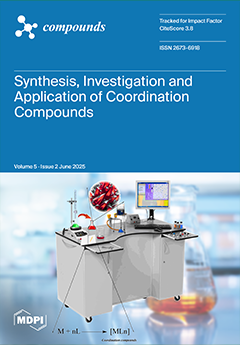This work describes the synthesis, crystal structure, and hydrophobicity tests of four bismuth(III)– and silver(I)–bromide complexes using the triammonium cations diethylenetriaminonium (H
3DETA
3+) and N,N,N′,N″,N‴-pentamethyldiethylenetriammonium (H
3PMDTA
3+). The prepared compounds are the 0D perovskites (H
3DETA)[BiBr
[...] Read more.
This work describes the synthesis, crystal structure, and hydrophobicity tests of four bismuth(III)– and silver(I)–bromide complexes using the triammonium cations diethylenetriaminonium (H
3DETA
3+) and N,N,N′,N″,N‴-pentamethyldiethylenetriammonium (H
3PMDTA
3+). The prepared compounds are the 0D perovskites (H
3DETA)[BiBr
6] (
1), (H
3DETA)
2[AgBr
4]Br
3 (
2), and (H
3PMDTA)[BiBr
6] (
3), as well as the 1D/2D mixed perovskite with minimum formula (H
3PMDTA)[Ag
3Br
6] (
4), being the last three novel materials. Compounds
1 and
3 crystallize in the orthorhombic
P2
12
12
1 space group and are discrete [BiBr
6]
3− units with the cation surrounding them. In both compounds, the bismuth(III) metal ion is found in a distorted octahedral coordination geometry. Compound
2 crystallizes in the monoclinic
P2
1/
c space group, and it is a mixed salt consisting of (H
3DETA)[AgBr
4] and (H
3DETA)Br
3, whereas the silver(I) complexes are also isolated. Finally, compound
4, which crystallizes in the orthorhombic space group
Pbcn, is a combination of a 2D and 1D silver–bromide perovskite, with the cations filling the voids. The 2D structure has the minimal formula [Ag
4Br
7]
3−, with the 1D coordination polymer [Ag
2Br
5]
3− being both built up by a combination of bromide ions acting as tetrahedra corner and edge-sharing bridging ligands. The silver(I) in
2 and
4 is found in a tetrahedral coordination geometry. All compounds were deposited on pristine FTO glass, resulting in an increase in the contact angle from 22° to 44°, 36°, 62°, and 54° for films of
1,
2,
3, and
4, respectively. Compounds
1 and
3 were also deposited onto Cs
2AgBiBr
6 film, and the contact angles were observed to be the same as when deposited directly onto the FTO cover glass.
Full article





